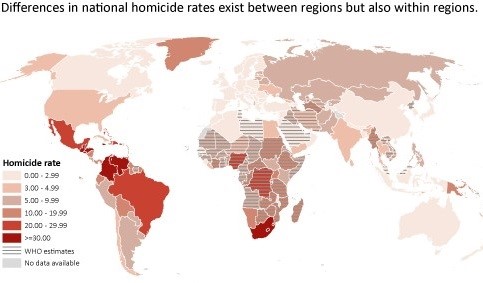Trends and patterns in victimization to domestic and non-domestic homicide
In the Netherlands, we lack studies on the trends of homicide victimization. How can Verkko’s static and dynamic law be used to analyse the trends of homicide victimization in the Dutch context?
Homicide rates have been declining the past few decades; each year there are fewer victims to homicide. Yet if we examine this decline more closely, we see distinct patterns in victimization. This blog focuses on how the so-called Verkko’s ‘laws’ may explain how homicide victimization patterns can be linked to changes in rates of homicide, and how the homicide drop in the Netherlands can be explored.
Some people are at higher risk of becoming a victim to homicide than others. For example, most homicide victims are men. In fact, their rate of victimization is four times greater than for women worldwide. Moreover, at a global level, the likelihood of victimization varies between and within countries and continents. Veli Verkko (1893-1955) a Finnish pioneer of international comparative homicide research introduced two laws. The first is the so-called ‘static law’, which states that variations of victimization are reflected in the share of female victims relative to the overall homicide rate. The higher the overall rate of homicide, the lower the percentage of female victims. Male-to-male violence is thus associated with high rates. This law is called ‘static’ because it explains variations in homicide rates at one moment in time, but does not focus on changes over time.

Source: UNODC; Global Study on Homicide 2013
Homicide can roughly be classified into domestic and non-domestic homicide. How did victimization to these subtypes of homicide evolve over time? Temporal changes in homicide rates are mainly related to changes in the share of male-to-male violence over time, according to Verkko’s second law, the ‘dynamic’ law. Domestic and non-domestic types of homicide differ in that respect. Domestic homicide entails the killing of a child, (current of former) partner, parent or other family member. Killings within the domestic setting mostly involve women as victims. This rate appears to remain relatively stable across time. This could be related to interpersonal conflicts within the familial sphere. These will always take place, regardless of the time period.
Non-domestic homicide involves killing of strangers and victims of robbery, nightlife violence, sexual assault and drug-related crimes, mostly involving men as victims. Killings that take place in these non-domestic settings are dominated by male-to-male homicides. Male-to-male homicides fluctuate more across time and place than rates of domestic lethal violence do. Thus, non-domestic homicide, building on Verkko’s ideas, needs more exploring to further our understanding of the homicide drop.
Both domestic and non-domestic violence involve a wide range of types of homicide. It is worthwhile to explore whether the decline in homicide rates is different for subtypes. For example, although victimization by non-domestic homicide tends to fluctuate over time, there are exceptions to this rule. Robbery crime accounted for stable five percent of global rates, whereas drug– and/or gang related homicides were more subject to change. Similarly, for domestic homicide, victimization rates may vary between different subtypes.
Previous studies examined the reasons for declining trends in lethal violence. However, we still lack studies on victimization patterns specifically focusing on the Dutch context. This clearly calls for more research focusing on subtypes of homicide, making use of Verkko’s ideas on homicide disaggregation.
A current research project by the Interpersonal Violence Research Group at ISGA focuses on domestic and non- domestic homicide, and aims to explore these patterns and explaining the declining trend in homicide of the last decades.


